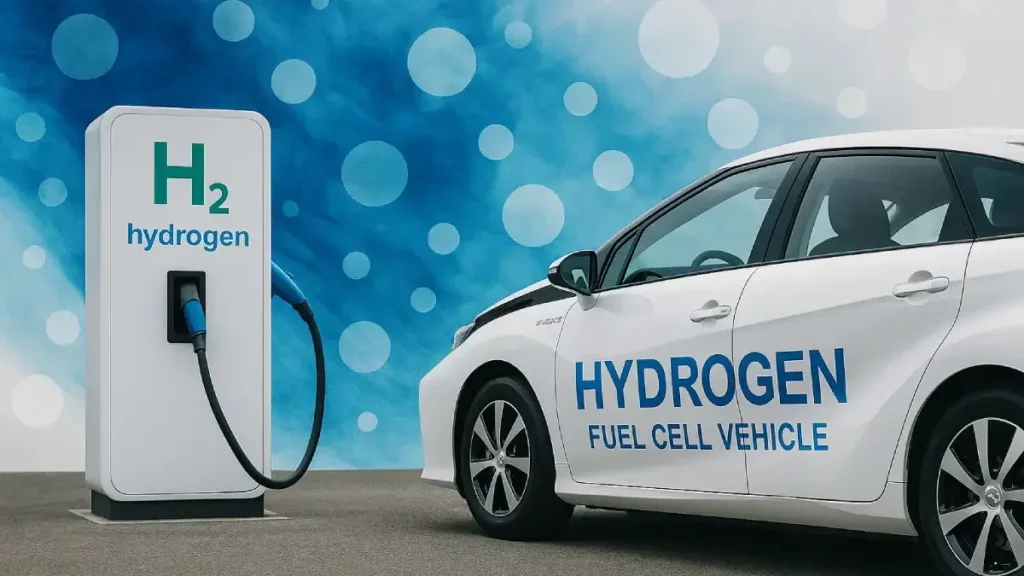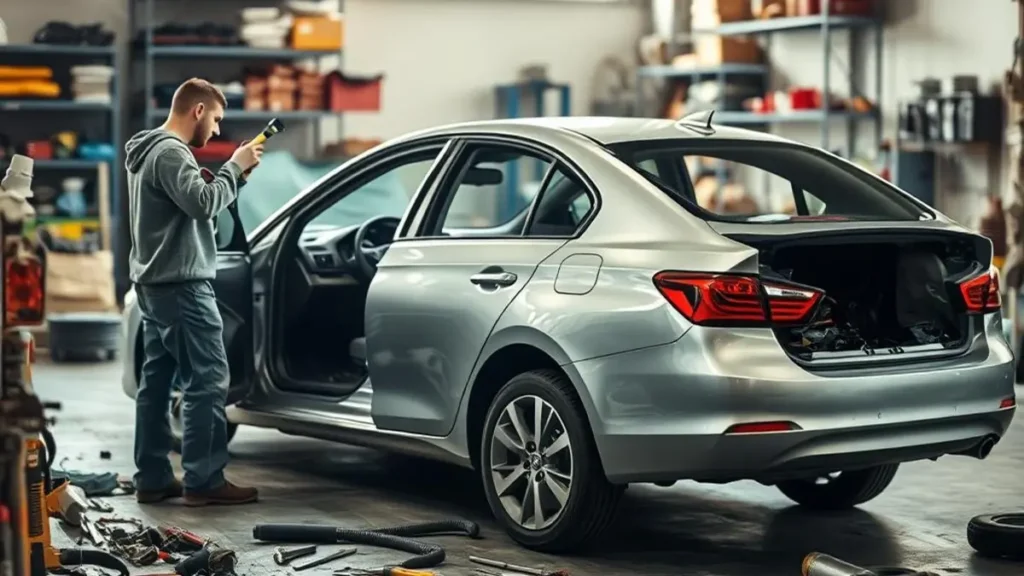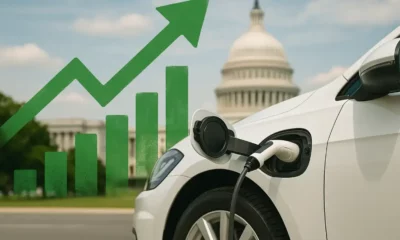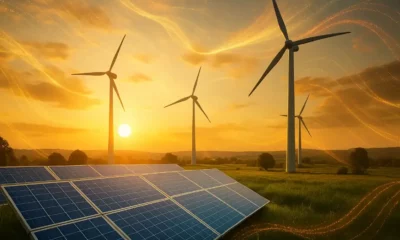Hydrogen Fuel Cell Vehicles: Revolutionizing the Future of Green Transportation
Hydrogen Fuel Cell Vehicles: Revolutionizing the Future of Green Transportation
Estimated reading time: 15 minutes
Key Takeaways
- Zero Tailpipe Emissions: Hydrogen fuel cell vehicles (FCEVs) produce only water vapor, significantly improving local air quality.
- Quick Refueling & Long Range: FCEVs offer refueling times of 3-5 minutes and ranges comparable to gasoline cars (300-400 miles), addressing range anxiety often associated with EVs.
- Infrastructure is Key: The biggest hurdle is the lack of widespread hydrogen refueling stations, limiting availability mainly to specific regions like California.
- Green Hydrogen Matters: The environmental benefit hinges on using “green hydrogen” (produced with renewable energy) to achieve truly low lifecycle emissions, as most current hydrogen production releases CO₂.
- Complementary Technology: FCEVs aren’t necessarily replacing battery EVs but are emerging as a potentially better solution for heavy-duty transport (trucks, buses) and specific long-range applications.

Table of Contents
- Introduction: The Drive Towards Clean Transport
- Understanding Hydrogen Fuel Cell Technology
- The Evolution of Fuel Cell Vehicles
- In-Depth EV Comparison: FCEVs vs. BEVs
- Environmental Impact Analysis
- Infrastructure and Adoption Challenges
- The Economics of Hydrogen Mobility
- Advancements in Hydrogen Technology
- Beyond Passenger Cars
- The Consumer Perspective
- The Future Outlook for Hydrogen
- Conclusion: Hydrogen’s Role
- Frequently Asked Questions
- Call to Action
Introduction: The Drive Towards Clean Transport
All around the world, people are thinking more about our planet. We are worried about how our cars and trucks affect the air we breathe and the world we live in. This has led to a big change towards finding cleaner ways to travel. We call this sustainable transportation.
One exciting new idea is hydrogen fuel cell vehicles (FCEVs). These special green cars use an alternative fuel – hydrogen – to make electricity and move. They are getting more popular as a way to drive without causing pollution. The market for vehicles using cleaner fuels is growing fast, showing that many people want these new options.
“Imagine driving a car that emits only water… FCEVs offer this possibility, but how do they compare to the EVs we already see on the roads?”
But how are hydrogen fuel cell vehicles different from the electric cars (EVs) that use batteries? This blog post will help you understand everything about hydrogen fuel cell technology. We’ll look at an EV comparison, see how these cars work, learn about their good points and challenges, and think about what they mean for the future of driving.
Source used for market growth context: GreenCars Overview
Source used for FCEV introduction: TWI Global FAQs
Understanding Hydrogen Fuel Cell Technology: How Does a Hydrogen Fuel Cell Work?
So, what makes these cars special? It’s the hydrogen tech inside them. At the heart of an FCEV is a hydrogen fuel cell. Think of it like a mini power plant. It’s a device that uses chemistry to turn hydrogen gas and oxygen from the air into electricity.
The amazing part? The only thing that comes out of the car’s tailpipe is water vapor! This means zero emissions while driving.
How it Works – Step by Step:
- Hydrogen In: Pure hydrogen gas (stored in a tank in the car) flows into one side of the fuel cell, called the anode.
- Splitting Atoms: Inside the fuel cell, a special layer called a catalyst (often made with platinum) helps split the hydrogen atoms. Each hydrogen atom is made of a proton and an electron.
- Electricity Creation: The electrons are forced to travel through a separate path, creating an electric current. This electricity flows to the car’s electric motor, making the wheels turn.
- Water Out: Meanwhile, the protons pass through a membrane in the middle of the fuel cell to the other side (the cathode). There, they meet oxygen taken from the air outside the car. The protons, electrons (after doing their work), and oxygen combine. This chemical reaction creates water (H₂O).
- Clean Exhaust: This water is released from the car as harmless water vapor.
[Imagine a simple diagram here: Hydrogen -> Anode | Membrane | Cathode <- Oxygen. Electrons flow out creating electricity. Protons cross membrane. Hydrogen + Oxygen + Electrons combine at Cathode -> Water Out.]
The Whole System:
A hydrogen fuel cell vehicle isn’t just the fuel cell stack itself. It also includes:
- Hydrogen Storage Tanks: Strong tanks designed to safely hold compressed hydrogen gas.
- Fuel Cell Stack: The main part where electricity is made. It’s usually made of many individual fuel cells stacked together.
- Electric Motor: Uses the electricity from the fuel cell stack to drive the wheels, just like in a battery electric car.
- Small Battery: Often, there’s a small battery too. It helps store energy captured from braking (regenerative braking) and provides extra power when needed, like during fast acceleration.
This hydrogen tech allows cars to run cleanly, achieving zero emissions on the road, making them a potentially important part of cleaner transportation.
Source used for fuel cell process: TWI Global FAQs
The Evolution of Fuel Cell Vehicles: From Concept to Road
The idea of using hydrogen to create power isn’t brand new. Fuel cell vehicles have been imagined and worked on for a long time. The basic idea of a hydrogen fuel cell was discovered way back in the 1800s! But turning it into a practical car took many years of science and engineering.
“From 19th-century science experiments to NASA spacecraft and finally to the cars on our roads today – the journey of fuel cell technology is a long one.”
Early prototypes were often large, expensive, and didn’t last very long. But step by step, scientists and car makers made big improvements. They found better materials, made the fuel cells smaller and more powerful, and figured out safer ways to store hydrogen.
Key Milestones:
- Early Concepts: Experiments with fuel cells happened over a century ago.
- Space Race Boost: NASA used fuel cells on spacecraft in the 1960s (like the Apollo missions) to provide electricity and drinking water for astronauts. This showed the technology could work reliably.
- Automotive Prototypes: In the 1990s and 2000s, major car companies started showing off concept fuel cell vehicles. These were often experimental and not ready for sale.
- First Commercial Models: The real breakthrough came in the 2010s when companies started leasing and selling FCEVs to the public, mainly in areas with some hydrogen fueling stations.
Leading Manufacturers Today:
While several companies have researched FCEVs, a few are leading the way with cars you can actually find (though usually only in specific places):
- Toyota Mirai: One of the most well-known FCEVs, now in its second generation. Toyota has strongly supported hydrogen as an alternative fuel.
- Hyundai Nexo: A stylish SUV powered by a hydrogen fuel cell, showing the technology can work in different vehicle types.
- Honda Clarity Fuel Cell: Although Honda stopped making the Clarity line (including the fuel cell version) in 2021, it was an important early player in the market. (See available models).
Market Status and Availability:
Right now, buying or leasing a fuel cell vehicle is not as easy as buying a regular car or even a battery electric car. Availability is mostly limited to places with hydrogen fueling stations, like California in the US, and some parts of Japan and Europe. The number of these cars on the road is still small compared to gasoline cars or battery EVs.
Why are car makers still investing in this alternative fuel technology? Many see it not as a replacement for battery EVs, but as another important tool. They believe hydrogen might be better for certain uses, like long-distance driving or heavy trucks, working alongside batteries to create a cleaner future for transport.
Source used for available models: Car and Driver Features
In-Depth EV Comparison: Hydrogen Fuel Cell Vehicles vs. Battery Electric Vehicles
When people think about green cars, the two main choices that come up are hydrogen fuel cell vehicles (FCEVs) and battery electric vehicles (BEVs or just EVs). Both use electric motors, run quietly, and don’t produce pollution from their tailpipes. But they get their electricity in different ways, leading to some important differences. Let’s make an EV comparison.
Key Differences Table:
| Feature | Hydrogen Fuel Cell Vehicles (FCEVs) | Battery Electric Vehicles (BEVs/EVs) |
|---|---|---|
| How it Works | Makes electricity onboard from hydrogen | Stores electricity from the grid in a large battery |
| Driving Range | Often 300-400 miles (around 500-650 km) per tank | Varies widely (150-500+ miles / 240-800+ km) per charge |
| “Fueling” Time | 3-5 minutes to refill hydrogen tank | 20 minutes (fast charging) to 12+ hours (home charging) |
| Energy Efficiency | Around 40-60% (from hydrogen tank to wheels) | Around 70-90%+ (from grid charging point to wheels) |
| Tailpipe Emissions | Only Water Vapor (H₂O) | None |
| Infrastructure | Very limited hydrogen stations, mainly in certain areas | Growing network of public chargers + home charging option |
| Vehicle Weight | Potentially lighter than long-range BEVs (tanks vs big batteries) | Large batteries add significant weight |
| Driving Feel | Quiet, smooth, quick acceleration (electric motor) | Quiet, smooth, quick acceleration (electric motor) |
Range and Refueling/Recharging:
This is a big difference. FCEVs often have a driving range similar to gasoline cars, and refilling the hydrogen tank takes only a few minutes, much like filling up with gas. This convenience is a major advantage. BEVs have ranges that vary a lot depending on the model and battery size. Recharging can take much longer, from quick top-ups at fast chargers to overnight charging at home.
“5 minutes at the pump vs. hours plugged in? The refueling experience is a key differentiator between FCEVs and BEVs.”
Energy Efficiency:
While FCEVs are much more efficient than gasoline cars, they are generally less efficient than BEVs. Making electricity from hydrogen involves energy conversion steps that lose some energy. BEVs use electricity more directly from the battery to the motor, resulting in higher overall efficiency from the “plug” to the wheels (see FCEV efficiency details). However, the efficiency of producing the hydrogen or the electricity in the first place also matters (more on that later).
Weight Considerations:
Large battery packs needed for long-range BEVs are very heavy. Hydrogen tanks, while needing to be very strong, can potentially weigh less than a massive battery for the same range, especially for larger vehicles. This weight difference can affect how the car handles and its overall efficiency.
Maintenance and Longevity:
Both FCEVs and BEVs have fewer moving parts in their powertrains compared to gasoline cars, which could mean less maintenance. Electric motors are known for their durability. Fuel cell stacks have improved a lot but their long-term lifespan and replacement cost are still areas being studied and improved. Batteries also degrade slowly over time.
Where Each Shines:
- Hydrogen Fuel Cell Vehicles: Might be better suited for drivers who need long range, quick refueling (similar to gas cars), or for heavier vehicles like trucks and buses where very large, heavy batteries would be impractical.
- Battery Electric Vehicles: Great for daily commuting, drivers with access to home or workplace charging, and where a wide charging network already exists. Their higher efficiency can be an advantage if the electricity source is clean.
This EV comparison shows that both types of green cars have strengths. The best choice depends on driving needs, available infrastructure, and how the energy (hydrogen or electricity) is produced.
Source used for range/refueling: TWI Global FAQs
Source used for FCEV infrastructure context: NREL Report
Source used for FCEV efficiency: TWI Global FAQs
Environmental Impact Analysis: Are Hydrogen Cars Truly Zero Emissions?
One of the biggest selling points for hydrogen cars is their zero emissions tailpipe – they only release water vapor. This is great for air quality in cities. But to understand the full environmental picture of these alternative fuel vehicles, we need to look at the entire lifecycle, especially how the hydrogen fuel itself is made. Not all hydrogen is created equal when it comes to being “green.”
“Zero emissions from the car is fantastic, but where does the hydrogen fuel come from? That’s the crucial question for overall sustainability.”
How Hydrogen is Made (The Colors of Hydrogen):
- Gray Hydrogen: This is the most common type today. It’s made from natural gas (methane) using a process called steam reforming. This process releases carbon dioxide (CO₂), a greenhouse gas that contributes to climate change. So, while the car is zero-emission, making the fuel is not.
- Blue Hydrogen: This is also made from natural gas, but the CO₂ produced during the process is captured and stored underground (Carbon Capture and Storage – CCS). This reduces the emissions compared to gray hydrogen, but it’s not completely emission-free, and storing CO₂ has its own challenges and costs.
- Green Hydrogen: This is the cleanest kind. It’s made using a process called electrolysis, which splits water (H₂O) into hydrogen (H₂) and oxygen (O₂). The key is that the electricity used for electrolysis comes from renewable sources, like solar or wind power. This way, making the hydrogen fuel creates virtually no greenhouse gas emissions. This is the goal for truly sustainable hydrogen green cars.
Comparing to Battery EVs:
Battery electric vehicles also have zero emissions from the tailpipe. Their environmental impact depends heavily on how the electricity used to charge them is generated. If the electricity comes from coal or natural gas power plants, then charging the EV still contributes to emissions, just at the power plant instead of the car. If the electricity comes from renewable sources like solar, wind, or hydro power, then the EV’s lifecycle emissions are much lower.
Resource Requirements:
- Fuel Cells: Currently, many hydrogen fuel cells use platinum as a catalyst. Platinum is rare and expensive. Researchers are working hard to use less platinum or find alternative materials.
- Batteries: EV batteries need materials like lithium, cobalt, and nickel. Mining these materials can have environmental and social impacts, depending on where and how they are mined. Recycling batteries effectively is also very important.
Overall Sustainability:
For both hydrogen FCEVs and battery EVs to be truly sustainable green cars, the energy used to power them must come from clean sources. For FCEVs, this means moving towards green hydrogen production. For BEVs, it means powering the electricity grid with more renewable energy. The environmental impact depends heavily on the source of the hydrogen.
The debate isn’t just about the car itself, but the entire energy system behind it. Using gray hydrogen for an FCEV might not be much better for the climate than a very efficient gasoline car, while using green hydrogen makes it a truly zero emissions solution over its lifecycle. Similarly, an EV charged with renewable electricity is much cleaner than one charged with coal-fired power.
Source used for hydrogen production impact: Earth.org Comparison
Infrastructure and Adoption Challenges: Building the Hydrogen Highway
A great car needs fuel to run. For hydrogen fuel cell vehicles, that means needing hydrogen refueling stations. This is currently one of the biggest challenges holding back widespread adoption of this hydrogen tech.
The Current Situation:
- Few Stations: Compared to the thousands of gas stations or the growing number of EV charging points, hydrogen refueling stations are rare.
- Concentrated Locations: Most existing stations are clustered in specific areas where governments and companies are actively supporting fuel cell vehicles. California is a key example in the US, along with countries like Japan and Germany. If you don’t live near one of these stations, owning an FCEV is simply not practical.
- Building Costs: Setting up a hydrogen refueling station is expensive. It involves complex equipment to store and dispense high-pressure hydrogen gas safely. This cost makes it hard for businesses to build stations without strong government support or a guarantee that many FCEVs will use them.
“Which comes first: the hydrogen cars or the hydrogen stations? This ‘chicken and egg’ problem is a major roadblock for FCEV adoption.”
The “Chicken and Egg” Problem:
This leads to a classic dilemma:
- People won’t buy fuel cell vehicles if there aren’t enough places to refuel them.
- Companies won’t build expensive refueling stations if there aren’t enough cars on the road to make it profitable.
This cycle makes it difficult for the technology to grow quickly.
Comparison to EV Charging:
Building out the EV charging network has also been a challenge, but it has some advantages. People can charge EVs at home overnight, which handles most daily driving needs. Public chargers are needed for longer trips or for people without home charging, but the basic “fueling” can often happen at home. You can’t make hydrogen fuel at home, so FCEV drivers rely entirely on public stations.
Expansion Plans and Government Support:
Governments that see potential in hydrogen fuel cell technology are trying to break the “chicken and egg” cycle. They offer funding to help build stations and give incentives (like tax credits or rebates) to people who buy FCEVs.
- California’s Goal: For example, California has ambitious plans to significantly increase its network of hydrogen stations, aiming for 200 stations by 2025 to support a growing number of fuel cell vehicles. Progress towards this goal is ongoing but faces funding and logistical hurdles.
These government policies and investments are crucial for developing the necessary infrastructure to make hydrogen tech a viable option for more drivers. Without more stations, FCEVs will remain limited to small, specific markets.
Source used for infrastructure status/California goal: NREL Report
The Economics of Hydrogen Mobility: What Does It Cost?
Switching to a new type of car always raises questions about cost. How do hydrogen fuel cell vehicles stack up when it comes to your wallet? Let’s break down the economics of this alternative fuel technology.
Key Cost Factors:
- Purchase Price: Currently, fuel cell vehicles are generally more expensive to buy than similar-sized gasoline cars or many battery electric vehicles. The complex technology, especially the fuel cell stack using precious metals like platinum, and low production volumes contribute to this higher price.
- Hydrogen Fuel Cost: The price of hydrogen fuel can vary significantly depending on the location and how it’s produced. Sometimes, it’s priced per kilogram (kg). One kg of hydrogen might give a similar range to a gallon of gasoline, but costs can be higher. Comparing the cost per mile to gasoline or electricity rates is important.
- Maintenance: Like battery EVs, FCEVs have fewer moving parts than gasoline cars (no oil changes, different brake wear due to regenerative braking). However, the fuel cell system itself is complex. While designed for durability (often aiming for similar lifespans as conventional cars), long-term maintenance costs and potential stack replacement costs are still being fully understood as more cars spend longer on the road.
- Incentives and Rebates: Governments often offer significant financial incentives (tax credits, rebates) to encourage people to buy low- or zero-emission vehicles, including FCEVs. These can dramatically lower the effective purchase price.
- Manufacturer Fuel Perks: To help overcome high fuel costs and limited station availability, some manufacturers (like Toyota with the Mirai) have offered complimentary hydrogen fuel for several years or up to a certain value with the purchase or lease of a new fuel cell vehicle. This can make a big difference in the early years of ownership.
“High upfront cost + potentially high fuel cost vs. government incentives + free fuel perks = a complex calculation for potential FCEV owners.”
Total Cost of Ownership (TCO):
When considering costs, it’s best to look at the Total Cost of Ownership (TCO). This includes the purchase price (minus incentives), fuel costs, insurance, and maintenance over the lifetime you plan to own the car. For FCEVs, TCO can be competitive with other vehicles, especially if generous fuel incentives are included and maintenance proves reliable. However, fuel costs after the initial incentive period can be a major factor.
Future Cost Reductions:
Like many new technologies, the cost of hydrogen fuel cell vehicles is expected to decrease over time. As manufacturers produce more vehicles (scale economies), the cost per car should drop. Research into using less platinum or alternative catalysts, improving manufacturing processes, and lowering the cost of hydrogen production (especially green hydrogen) will all help make these alternative fuel cars more affordable in the future.
Right now, the economics often depend heavily on location-specific incentives and fuel programs. As the technology matures and infrastructure grows, the financial picture for FCEVs should become clearer and potentially more attractive.
Source used for cost context & fuel incentives: TWI Global FAQs
Advancements in Hydrogen Technology: Making FCEVs Better and Cheaper
The hydrogen tech used in cars today is already impressive, but scientists and engineers are constantly working to make it even better. These advancements aim to lower costs, improve performance, and make hydrogen fuel cell vehicles more practical and durable.
Key Areas of Innovation:
- New Catalyst Materials: Fuel cells currently rely heavily on platinum, which is expensive and rare. A major focus is finding ways to:
- Use much less platinum (thinner coatings, more efficient structures).
- Replace platinum entirely with cheaper, more abundant materials like iron or cobalt-based catalysts. This could significantly reduce the cost of the hydrogen fuel cell stack.
- Improved Hydrogen Storage: Storing hydrogen gas safely and efficiently is crucial. Current tanks store hydrogen at very high pressures (700 bar, or over 10,000 psi). Research is exploring:
- Even higher pressure tanks to store more fuel in the same space, increasing range.
- New materials (metal hydrides, sorbents) that could store hydrogen in a solid state at lower pressures, potentially making tanks smaller, lighter, and safer.
- Cryo-compressed hydrogen storage combines high pressure with very low temperatures.
- Manufacturing Efficiencies: As production volumes increase, manufacturers are finding ways to build fuel cells and their components faster and cheaper. Automation and streamlined assembly lines help lower the overall cost of the vehicle.
- Enhanced Durability and Lifespan: Early fuel cells sometimes had limited lifespans. Today’s hydrogen fuel cells are designed to last much longer, often aiming for 150,000 miles or more, similar to conventional engines. Ongoing research focuses on making the internal components (like the membranes and catalysts) even more resistant to degradation over time and under various driving conditions.
“Reducing platinum use, finding better ways to store hydrogen, and improving manufacturing – these are the keys to unlocking affordable, widespread FCEVs.”
Investment and Timelines:
Car manufacturers, energy companies, and governments are investing billions of dollars into hydrogen tech research and development. While some advancements, like reducing platinum use, are already appearing in newer FCEV models, others, such as radically new storage methods, might take longer to become commercially available. The pace of innovation is rapid, suggesting continued improvements in the coming years.
Beyond Cars: Broader Energy Role:
Hydrogen’s potential extends far beyond just powering cars. Advances in producing, storing, and using hydrogen (especially green hydrogen made from renewables) could play a vital role in the broader energy system. Hydrogen can be used for:
- Storing excess energy generated from solar and wind power.
- Providing clean fuel for industries that are hard to electrify directly.
- Heating buildings.
Progress in hydrogen tech for vehicles often benefits these other applications, and vice versa, creating a larger ecosystem for this versatile alternative fuel.
Source used for general tech context: TWI Global FAQs
Beyond Passenger Cars: The Broader Potential of Hydrogen Fuel Cell Vehicles
While much of the focus is on passenger cars, the unique advantages of hydrogen tech might make fuel cell vehicles even better suited for other types of transportation, especially larger, heavier applications where achieving zero emissions with batteries alone is more challenging.
“Think bigger than cars: hydrogen’s ability to offer long range and quick refueling makes it a strong contender for trucks, buses, trains, and even ships.”
Where Hydrogen Shines:
- Heavy-Duty Trucks: Long-haul trucking requires covering vast distances with heavy loads. Batteries large enough to provide sufficient range would be extremely heavy, reducing cargo capacity and requiring very long charging times. Hydrogen offers long range and quick refueling (potentially 10-15 minutes for a truck), making FCEV trucks a promising solution for decarbonizing freight transport. Several companies are actively developing and testing hydrogen trucks.
- Buses: City buses run on fixed routes and return to a central depot, making refueling easier to manage. Hydrogen buses can offer long operating ranges and quick refueling, allowing them to run routes all day without losing time to charging. Many cities worldwide are already using hydrogen buses in their public transport fleets.
- Material Handling (Forklifts): Hydrogen fuel cells have been used successfully in forklifts in large warehouses and distribution centers for years. They offer advantages over battery-powered forklifts, such as consistent power delivery (no slowdown as the battery drains) and very fast refueling (minutes instead of hours for battery swaps or charging), maximizing uptime.
- Trains: In areas where electrifying railway lines with overhead wires is too expensive or difficult (e.g., non-main lines, scenic routes), hydrogen-powered trains (hydrail) offer a zero emissions alternative to diesel trains. Prototypes and commercial services are already running in countries like Germany.
- Maritime Applications (Ships and Ferries): For ships, especially ferries and potentially larger vessels, batteries may not provide enough energy for long voyages. Hydrogen and related fuels like ammonia (which can be made from hydrogen) are being explored as clean alternative fuel options for the shipping industry to reduce its significant greenhouse gas emissions.
Why Hydrogen Fits These Applications:
- Range and Payload: The energy density of hydrogen systems (combined weight of fuel and tanks) can be advantageous over batteries for applications needing very long range or carrying heavy loads.
- Refueling Speed: The ability to refuel quickly is critical for commercial vehicles that need to operate continuously with minimal downtime.
- Centralized Refueling: Many commercial fleets (buses, trucks, forklifts) operate from central depots where installing dedicated hydrogen refueling infrastructure is more feasible than building a widespread public network.
While passenger FCEVs face infrastructure hurdles, the application of hydrogen tech in these heavier-duty sectors is already demonstrating its value and contributing to achieving zero emissions in diverse transportation modes.
The Consumer Perspective: Living with a Hydrogen Car
Thinking about buying one of the available hydrogen fuel cell vehicles? As one of the potential green cars options, it offers a unique experience but also comes with practical things to consider.
Driving Experience:
- Quiet and Smooth: Like battery EVs, hydrogen fuel cell vehicles use electric motors, so they are very quiet and offer smooth, instant acceleration. Driving is generally relaxing and responsive.
- Familiar Feel: Apart from the quietness, the driving dynamics often feel similar to a conventional modern car.
Availability and Location:
- Limited Choice: Currently, there are only a couple of FCEV models available for sale or lease (like the Toyota Mirai and Hyundai Nexo).
- Geographic Restriction: The biggest factor is where you live. You absolutely need convenient access to hydrogen refueling stations. These are mostly found in California and a few other specific global regions. Check hydrogen station maps (like the one from the California Fuel Cell Partnership) before even considering an FCEV.
“Living with an FCEV today means being an early adopter: enjoying the drive and quick refueling, but carefully planning around the limited station network.”
Refueling Process:
- Like Pumping Gas, But Different: Refueling involves connecting a specialized nozzle from the hydrogen pump to the car’s receptacle. The process is automated and takes about 3-5 minutes to fill the tank.
- High Pressure: The hydrogen is dispensed under very high pressure, so the equipment is robust. It’s designed to be safe and easy to use, but it looks and feels a bit different from a gasoline pump.
Maintenance:
- Simplified Compared to Gas: No oil changes are needed. Brake wear might be reduced thanks to regenerative braking (where the electric motor helps slow the car and recovers energy).
- Specialized Service: Maintenance related to the fuel cell stack or high-pressure hydrogen system requires technicians trained specifically on hydrogen fuel cell vehicles. Service might only be available at select dealerships certified for FCEV maintenance. Check dealer locations and capabilities.
Safety:
- Designed for Safety: FCEVs must meet the same rigorous safety standards as all other cars. Hydrogen tanks are incredibly strong, built to withstand high-impact crashes, and tested extensively. Systems are designed to detect leaks and shut off hydrogen flow immediately if a problem occurs.
- Hydrogen Myths: Some people worry about hydrogen because it’s flammable. However, hydrogen is much lighter than air, so if it leaks, it disperses very quickly upwards, unlike gasoline which pools on the ground. Safety systems are designed with hydrogen’s properties in mind.
User Insights:
Owners often praise the smooth driving experience, long range, and quick refueling times. However, frustrations can arise from the limited number of stations, occasional station downtime, or variability in hydrogen fuel prices (especially after initial manufacturer incentives end).
EV Comparison: Ownership Experience:
- FCEV: Feels very similar to owning a gasoline car in terms of range and refueling time, BUT only if you live near reliable stations. Fuel costs can be higher than electricity.
- BEV: Offers the convenience of home charging for most daily needs. Public charging network is much larger but charging times (especially on longer trips) can be significant. Electricity is often cheaper per mile than hydrogen or gasoline.
Choosing an FCEV today means being an early adopter, prioritizing quick refueling and long range within specific geographic areas where infrastructure exists. It’s a different kind of green car experience compared to owning a battery EV.
Source used for available models: Car and Driver Features
The Future Outlook for Hydrogen in Transportation: What’s Next?
What does the road ahead look like for hydrogen fuel cell technology in transportation? While challenges remain, ongoing developments and strategic investments suggest hydrogen will play a role, likely alongside battery electric power, in the future of mobility.
Industry Forecasts and Timelines:
- Predicting exact adoption rates is difficult. Most experts expect battery EVs to dominate the passenger car market in the near to mid-term due to existing infrastructure advantages and falling battery costs.
- However, many forecasts see significant growth for hydrogen fuel cells in heavy-duty transport (trucks, buses, ships, trains) starting in the late 2020s and into the 2030s.
- Long-term adoption in passenger cars depends heavily on infrastructure build-out and cost reductions for both vehicles and green hydrogen fuel.
Potential Breakthroughs:
Several factors could speed up the adoption of hydrogen tech:
- Cheaper Green Hydrogen: Major breakthroughs in electrolysis technology or large-scale deployment of renewable energy could significantly lower the cost of green alternative fuel, making FCEVs more economical to run.
- Infrastructure Investment: Coordinated government and private investment to rapidly expand the hydrogen refueling network beyond current clusters is crucial.
- Cost-Effective Fuel Cells: Success in replacing or drastically reducing platinum in fuel cells would lower vehicle purchase prices.
- Improved Storage: New hydrogen storage methods that are cheaper, lighter, or store more fuel could enhance vehicle range and design.
“The ‘hydrogen economy’ isn’t just about cars – it envisions hydrogen playing a key role across energy and industry, which could boost its use in transportation too.”
The Hydrogen Economy Vision:
The push for hydrogen in transport is often part of a bigger vision: a “hydrogen economy.” In this vision, clean hydrogen (mostly green) is produced at scale and used not just for vehicles, but also for:
- Industrial processes (like making steel or chemicals)
- Generating electricity when renewables aren’t available (energy storage)
- Heating homes and buildings
Transportation would be just one piece of a larger, integrated clean energy system relying on hydrogen tech.
Complementary Roles:
Instead of viewing it as Hydrogen vs. Batteries, many experts see a future where both technologies coexist, each excelling in different areas:
- Batteries: Likely ideal for passenger cars, urban delivery vans, and shorter routes where charging time is less critical.
- Hydrogen: Better suited for long-haul trucking, buses, trains, ships, and potentially some passenger vehicles needing very long range and fast refueling.
Global Approaches:
Different parts of the world are tackling hydrogen mobility with varying levels of enthusiasm and focus:
- Asia (Japan, South Korea, China): Strong government support and industry investment in both vehicles and infrastructure. Japan has long championed a hydrogen society.
- Europe (especially Germany): Significant investment in hydrogen, particularly green hydrogen, with a focus on heavy industry and transport, including trucks and trains.
- North America (especially California): Leading FCEV adoption in the US, driven by state policies and infrastructure funding, though deployment is geographically concentrated.
The future path of hydrogen fuel cell transport will likely vary by region and depend on continued technological progress, supportive policies, and the falling cost of clean hydrogen production. It remains a key alternative fuel technology to watch in the transition to sustainable mobility.
Conclusion: Hydrogen’s Role in the Green Driving Revolution
Hydrogen fuel cell vehicles represent a truly innovative approach to cleaning up our roads. They offer the exciting promise of driving with zero emissions, releasing only water vapor, which helps improve air quality and fights climate change.
Key advantages include long driving ranges similar to gasoline cars and refueling times of just a few minutes. This makes them feel very convenient, especially for drivers used to traditional vehicles or those who need to cover long distances regularly.
However, significant challenges remain. Building a widespread and reliable hydrogen refueling infrastructure is expensive and faces a “chicken and egg” problem with vehicle adoption. The current cost of hydrogen fuel cell vehicles is often higher than comparable gasoline or battery electric cars. Critically, for hydrogen to be a truly green car solution, the alternative fuel needs to be produced using clean, renewable energy (green hydrogen), as current methods often rely on fossil fuels.
“Hydrogen fuel cells offer a compelling vision for clean transport, but unlocking their full potential requires solving infrastructure and green fuel production challenges.”
The future of transportation will likely not be about one single winner. Instead, we’ll probably see a mix of technologies working together. Battery electric vehicles are well-suited for many passenger car needs, especially with growing charging networks and home charging options. Hydrogen fuel cell vehicles may find their sweet spot in heavy-duty transport like trucks and buses, and potentially for drivers needing the longest ranges and fastest refueling.
Success depends heavily on continued advancements in hydrogen tech to lower costs and improve performance, alongside major investments in building out refueling stations and scaling up green hydrogen production.
As consumers increasingly look for green cars and cleaner ways to travel, hydrogen fuel cell vehicles offer another important option to consider alongside battery EVs. Watching how the technology develops and how the supporting infrastructure grows will be key in the coming years.
Frequently Asked Questions (FAQ)
Q: What exactly is a hydrogen fuel cell vehicle (FCEV)?
A: It’s a type of electric vehicle that generates its own electricity onboard using a fuel cell. The fuel cell combines stored hydrogen gas with oxygen from the air, producing electricity to power the motor and emitting only water vapor.
Q: Are hydrogen cars safe?
A: Yes. FCEVs must meet strict safety standards like all other vehicles. Hydrogen tanks are extremely durable and tested for impacts. Safety systems are designed to detect leaks and shut off hydrogen flow if needed. Hydrogen gas is lighter than air and disperses quickly if released.
Q: How long does it take to refuel a hydrogen car?
A: Refueling takes about 3-5 minutes, similar to filling a gasoline car tank.
Q: Are hydrogen cars better than battery electric cars (BEVs)?
A: Neither is definitively “better”; they have different strengths. FCEVs typically offer longer range and much faster refueling, while BEVs have a much larger charging infrastructure (including home charging) and are generally more energy-efficient from plug/pump to wheel. The best choice depends on individual needs and local infrastructure.
Q: Where can I refuel a hydrogen car?
A: Hydrogen refueling stations are currently very limited and concentrated in specific areas, most notably California in the US, and parts of Japan and Europe. Widespread availability is a major challenge.
Q: Are hydrogen cars truly ‘zero emissions’?
A: They have zero tailpipe emissions (only water vapor). However, the overall environmental impact depends heavily on how the hydrogen fuel is produced. “Green hydrogen,” made using renewable electricity, is a near-zero lifecycle emission fuel, while “gray hydrogen,” made from natural gas, has significant associated CO₂ emissions.
Q: Are FCEVs expensive?
A: Currently, FCEVs often have a higher purchase price than comparable gasoline cars or many BEVs. Hydrogen fuel costs can also be higher than gasoline or electricity per mile. Government incentives and manufacturer fuel perks can help offset these costs. Costs are expected to decrease as the technology matures.
Call to Action
Are you interested in the future of clean transportation?
- Learn More: Find out if there are any hydrogen fuel cell vehicles available for lease or purchase in your specific region and use online maps (like those from the California Fuel Cell Partnership or H2Stations.org) to see where the nearest refueling stations might be.
- Stay Informed: Keep an eye on news about hydrogen infrastructure development in your area or country. Track progress on green hydrogen production initiatives. As more stations are built and cleaner fuel becomes available, these vehicles could become a more practical option.
- Share Knowledge: Did you find this post helpful? Share it with friends, family, or colleagues who are interested in alternative fuel sources, green cars, and the latest advancements in automotive technology. The future of driving is changing fast, and knowledge helps everyone make informed choices.
ACV vs Repair Cost: Understand Your Options After a Car Accident
Estimated reading time: 8 minutes
Key Takeaways
- Insurers total a vehicle when repair costs hit 70-75% of its Actual Cash Value (ACV).
- ACV is calculated by subtracting depreciation from the replacement cost and adjusting for market factors.
- Hidden damage discovered during repairs can increase costs, potentially leading to a total loss declaration.
- Negotiating with insurers using documented evidence can improve settlement payouts.
- Consider long-term reliability and financial implications before deciding to repair or accept a total loss settlement.
Navigate to What Matters

Introduction
After an accident, you face a critical financial decision: repair your vehicle or accept an insurance payout? Understanding the relationship between ACV vs repair cost can save you thousands of dollars and prevent costly mistakes.
Actual Cash Value (ACV) represents what your car is worth today, not what you paid for it. It factors in depreciation and current market conditions to determine your vehicle’s present value.
“The key to a successful claim is understanding how insurance companies assess damage and value vehicles.”
Understanding ACV vs Repair Cost
Repair cost, on the other hand, is the total expense required to restore your vehicle to its pre-accident condition, including parts, labor, and other necessary services.
When these two figures collide during the claims process, you need to understand how insurers make decisions and how you can protect your financial interests. See this information.
How Insurers Determine Total Loss
When insurance companies evaluate accident damage, they use a specific formula to decide whether your car is a “total loss” or worth repairing.
Most insurers follow the total loss threshold formula: if repair costs exceed 70-75% of your vehicle’s ACV, they’ll declare it a total loss. For example, if your car is worth $10,000, repairs exceeding $7,000-$7,500 would likely trigger a total loss declaration.
The evaluation process typically includes:
- Initial damage assessment by an insurance adjuster
- Detailed repair estimates from body shops
- Vehicle valuation based on make, model, year, and condition
- Calculation of the repair-to-value ratio
Different states have varying legal thresholds for total loss declarations. Some use a straight percentage (like 75%), while others use a Total Loss Formula (TLF) that considers salvage value alongside repair costs. For further reading on this, see our guide on understanding the total loss threshold by state (Total Loss Threshold by State).
Understanding how insurers determine total loss empowers you to question their assessment if you believe it’s unfair or inaccurate. Learn more (LINK TEXT) [https://www.kbb.com/car-advice/actual-cash-value/].
Actual Cash Value Car Calculation Explained
The actual cash value car calculation uses a relatively straightforward formula:
ACV = Replacement Cost – Depreciation + Market Adjustments
Replacement cost refers to what you’d pay for an identical vehicle in today’s market. Depreciation accounts for the vehicle’s decreased value over time, influenced by:
- Vehicle age (typically 15-25% depreciation in the first year)
- Mileage (high mileage accelerates depreciation)
- Pre-existing damage or wear
- Maintenance history
- Previous accidents
Market adjustments consider local market conditions, vehicle popularity, and special features that might increase value. To maximize your appeal, see what’s the best time to sell a car (Best Time to Sell a Car).
For example, a 2018 sedan with an original price of $25,000 might have a replacement cost of $20,000 today. With $8,000 in depreciation due to age, mileage, and condition, plus $1,000 in positive market adjustments for desirable features, the ACV would be:
$20,000 – $8,000 + $1,000 = $13,000
Understanding this calculation helps you verify whether your insurer’s valuation is fair and accurate. Find out more information (LINK TEXT) [https://www.experian.com/blogs/ask-experian/actual-cash-value-vs-replacement-cost-for-car-insurance/].
Interactive ACV Estimator Tool
To quickly estimate your vehicle’s ACV and compare it against repair costs, follow this simplified calculation:
- Find similar vehicles for sale in your area (check Kelley Blue Book or local listings)
- Calculate the average asking price
- Subtract for negative factors:
- Deduct 10-15% for high mileage (over 12,000 miles per year)
- Deduct 5-10% for poor condition
- Deduct 5-15% for accident history
- Add for positive factors:
- Add 3-5% for recent major repairs or upgrades
- Add 2-5% for desirable features
Let’s use this formula to compare ACV vs repair cost in a real-world scenario:
A 2017 Honda Accord with 70,000 miles has an average listing price of $16,500. With slightly high mileage (-5%) and good condition, the estimated ACV is $15,675. If repair costs after an accident are $12,000, that’s approximately 77% of the ACV—likely making it a total loss.
See also these examples.
Supplements and Hidden Damage
One of the most common complications in the ACV vs repair cost evaluation is the discovery of hidden damage after repairs begin. These additional repair costs, called “supplements,” can push a repairable vehicle over the total loss threshold.
Supplements typically occur when:
- Structural damage becomes visible only after disassembly
- Damaged parts reveal additional problems
- Safety systems require recalibration
- Parts availability issues increase labor costs
For example, what initially appears as $8,000 in repairs on a $12,000 vehicle (67% of ACV) might increase to $9,500 with supplements, pushing it to 79% and triggering a total loss declaration.
To protect yourself, ask the body shop for a thorough preliminary inspection and request they note potential hidden damage areas that could affect how insurers determine total loss.
Negotiation Tactics for Better Payouts
When facing a total loss situation, you don’t have to accept the first ACV offer from your insurer. Consider these negotiation strategies:
- Gather evidence of your vehicle’s value with screenshots of comparable vehicles for sale in your area
- Document recent improvements like new tires, brakes, or other major components
- Obtain an independent appraisal if the difference is significant
- Present maintenance records showing above-average care
- Research unique features that might increase value
- Consider the car’s pre-accident condition compared to average
The actual cash value car calculation isn’t set in stone. By presenting compelling evidence, you can often increase the insurer’s offer by 5-15%, potentially adding hundreds or thousands to your settlement.
Remember that adjusters initially aim for the lower end of the value range. Your documented research creates leverage for negotiation. If you decide to sell your car, review CarMax vs Carvana (CarMax vs Carvana Comparison) and decide where to sell it and get more money.
Decision-Making Tools
When weighing whether to repair your vehicle or accept a total loss settlement, consider using these resources:
- Replacement Vehicle Checklist: Compare your settlement amount against available replacement options in your market
- Instant Cash Offer tools: Get immediate valuations from services like Kelley Blue Book to verify the fairness of insurer offers
- Cost-benefit analysis: Consider future reliability and safety against the settlement amount
The ACV vs repair cost decision isn’t just about current numbers—it’s about future value and reliability. Sometimes accepting a total loss makes financial sense even when the threshold hasn’t been reached, especially with older vehicles where repair quality might not restore full functionality. After an accident, you may qualify for a diminished value claim (Diminished Value Claim Guide).
See this additional advice.
Below are answers to frequently asked questions about **ACV vs repair cost** decisions.
Understanding Total Loss Threshold by State and What It Means for Your Vehicle
Estimated reading time: 7 minutes
Key Takeaways
- Total loss thresholds vary by state, impacting insurance claim outcomes.
- Insurance companies use either a percentage rule or a formula to determine if a vehicle is a total loss.
- Understanding your state’s specific rules can help you negotiate a fair settlement.
Navigate to What Matters
![what to do if car is totaled [state]](https://nowee.org/wp-content/uploads/2025/09/image_0-1024x576.webp)
Introduction
When your car is damaged in an accident, insurance companies use the total loss threshold by state to determine if your vehicle should be repaired or declared a total loss. This critical percentage varies significantly depending on where you live, directly impacting your insurance claim outcome.
The total loss threshold is essentially the point at which repair costs exceed a certain percentage of your vehicle’s actual cash value (ACV). Understanding your state’s specific rules can help you navigate insurance claims more effectively and ensure you receive fair compensation.
“Each state follows either a specific percentage rule or a formula to determine when a car is considered totaled. These thresholds range from as low as 70% to as high as 100% of your car’s value.”
How Insurance Companies Determine Total Loss
Insurance providers typically use one of two methods to decide if your vehicle is a total loss:
The Totaled Car Percentage Rule
Many states establish a specific percentage threshold. When repair costs exceed this percentage of your vehicle’s ACV, the car must be declared a total loss.
For example, if your car has an ACV of $10,000 and your state’s threshold is 75%:
- Repair costs of $7,600 would exceed the threshold
- The vehicle would be declared totaled
- You would receive a settlement based on the ACV
The Total Loss Formula (TLF)
Some states use a formula rather than a fixed percentage. The formula works like this:
Cost of Repairs + Salvage Value ≥ Actual Cash Value = Total Loss
For example, if your $10,000 car needs $6,000 in repairs and has a salvage value of $4,500:
- $6,000 (repairs) + $4,500 (salvage) = $10,500
- Since $10,500 exceeds the $10,000 ACV, the car is totaled
This method considers both repair costs and what the vehicle would be worth as salvage; see this explanation.
State-by-State Total Loss Threshold Table
Use this quick reference guide to find your state’s specific threshold requirements:
| State | Threshold | Method |
|---|---|---|
| Alabama | 75% | Percentage of ACV |
| Alaska | TLF | Total Loss Formula |
| Arizona | TLF | Total Loss Formula |
| Arkansas | 70% | Percentage of ACV |
| California | TLF | Total Loss Formula |
| Colorado | 100% | Percentage of ACV |
| Connecticut | TLF | Total Loss Formula |
| Delaware | TLF | Total Loss Formula |
| Florida | 80% | Percentage of ACV |
| Georgia | 75% | Percentage of ACV |
| Hawaii | TLF | Total Loss Formula |
| Idaho | TLF | Total Loss Formula |
| Illinois | TLF | Total Loss Formula |
| Indiana | 70% | Percentage of ACV |
| Iowa | 75% | Percentage of ACV |
| Kansas | 75% | Percentage of ACV |
| Kentucky | 75% | Percentage of ACV |
| Louisiana | 75% | Percentage of ACV |
| Maine | TLF | Total Loss Formula |
| Maryland | 75% | Percentage of ACV |
| Massachusetts | TLF | Total Loss Formula |
| Michigan | 75% | Percentage of ACV |
| Minnesota | 70% | Percentage of ACV |
| Mississippi | TLF | Total Loss Formula |
| Missouri | 80% | Percentage of ACV |
Notable outliers include Texas with a 100% threshold, meaning repair costs must equal or exceed the full value of the car before it’s totaled, while Arkansas has one of the lowest thresholds at 70%.
Always verify current salvage threshold requirements for your specific state as regulations can change.
What Happens When Your Car Exceeds the Threshold
When your vehicle’s damage exceeds your state’s total loss threshold, several important processes begin:
Insurance Payout Based on ACV
Your insurance company will offer you a settlement based on your car’s Actual Cash Value, not the replacement cost. This valuation considers:
- Original purchase price
- Depreciation based on age
- Mileage and condition before the accident
- Recent sales of similar vehicles in your area
This payout is often negotiable if you can prove your car was worth more than the insurer’s initial offer.
Salvage Title Implications
Once declared a total loss, your vehicle will receive a salvage title designation. This classification has significant consequences:
- The car cannot be legally driven on public roads
- Most insurance companies won’t cover a salvage vehicle
- Resale value drops considerably
- Registration requires special inspections in most states
Understanding your state’s salvage threshold is crucial because this title status follows the vehicle permanently, even if repaired.
Smart Steps After a Total Loss Declaration
If your vehicle has been declared a total loss, take these proactive steps:
Verify the Assessment
Double-check that your car truly exceeds your state’s total loss threshold. Request detailed documentation showing:
- The complete repair cost estimate
- The calculation method used
- Your vehicle’s pre-accident value determination
Many insurers use third-party valuation tools that may undervalue your vehicle.
Negotiate Effectively
Don’t accept the first offer. To improve your negotiating position:
- Research comparable vehicles in your area
- Gather maintenance records showing your car’s excellent condition
- Document recent upgrades or new parts
- Get an independent appraisal if significant money is at stake
Remember, the totaled car percentage rule in your state establishes the minimum threshold, but you can still advocate for fair compensation. For assistance, see this overview.
Replacement Options
After accepting your vehicle’s total loss status, consider these replacement options:
Research Alternatives
Start your search for a replacement vehicle by:
- Comparing similar models within your settlement budget
- Checking both new and used inventory
- Considering certified pre-owned options with warranties
- Exploring lease takeovers for potential savings
Buyback Considerations
In many states, you can “buy back” your totaled vehicle from the insurance company:
- The insurer deducts the salvage value from your settlement
- You keep the damaged car along with a reduced payout
- The vehicle retains its salvage title status
- You’re responsible for repairs and special inspections
This option makes sense if your car has sentimental value or you believe you can repair it cost-effectively. More information can be found at Policygenius.
Conclusion
Understanding the total loss threshold by state empowers you to navigate insurance claims with confidence. These thresholds vary significantly across the country, with some states using strict percentage rules while others employ more complex formulas.
When facing a potential total loss situation, knowledge of your state’s specific requirements helps you verify insurance assessments and negotiate fair settlements. Remember that these thresholds establish minimum standards, but you always have the right to question valuations and repair estimates.
Take time to review your state’s particular total loss threshold before accepting any settlement offer. This simple step can potentially save you thousands of dollars and help you make more informed decisions about your vehicle’s future. Here is a quick checklist (48-Hour Checklist if Your Car is Totaled [State]); see this page for total loss appraisals.
Related reading:
- Understand the forces behind electric vehicle adoption (How Government Policies Impact EV Adoption)
- You may want to review diminshed value claim in your state (Diminished Value Claim [State]: Your Complete Guide to Recovering Lost Vehicle Value).
- Are you considering an electric car? (Choosing the Right Electric Vehicle: The Ultimate Guide for Families)
- Learn more about EV battery innovations (Battery Technology for EVs: The Driving Force Behind Electric Vehicle Innovation).
- Thinking about reducing waste? (Reducing Food Waste: How AI and Smart Kitchen Technology Are Transforming Sustainable Living)
Below are quick answers to common questions about total loss thresholds.
FAQs
How to Sell a Leased Car to CarMax: Step-by-Step Third-Party Payoff Guide
Estimated reading time: 7 minutes
Key Takeaways
- Selling a leased car to CarMax is possible via a third-party payoff.
- Not all leasing companies allow third-party payoffs; check your lease agreement.
- Equity can be captured if CarMax’s offer exceeds your lease payoff amount.
Introduction
Are you wondering if you can sell your leased car to CarMax and possibly walk away with some extra cash? The good news is that selling a leased car to CarMax is entirely possible through a process called third-party payoff.
With rising vehicle costs and market values, many drivers are discovering they have equity in their leased vehicles. This creates an opportunity to exit your lease early while potentially pocketing the difference between your car’s current value and the remaining lease payoff.
Let’s explore exactly how to sell a leased car to CarMax, navigate the third-party payoff process, and maximize your potential returns.
Navigate to What Matters

“Selling your leased car can be a win-win situation.”
Understanding Third-Party Lease Payoffs
A third-party lease payoff is the mechanism that allows you to sell your leased vehicle to CarMax without buying it yourself first. This process enables CarMax to purchase the vehicle directly from your leasing company.
When you sell a leased car to CarMax, they contact your lender to obtain the exact payoff quote. CarMax then handles the payment directly to your leasing company and manages any equity distribution if your car is worth more than the payoff amount.
However, not all leasing companies allow third-party payoffs. Some manufacturers and finance companies have implemented restrictions that require you to buy the car yourself before selling it. Honda, Acura, GM, and BMW are examples of brands that have placed such restrictions in recent years.
Your equity calculation is simple: the difference between CarMax’s offer and your lease payoff amount. If the offer exceeds your payoff, you receive the difference as profit. For more clarity on your options, explore (see Lease Buyout Calculator: Your Options).
Step-by-Step Process to Sell Your Leased Car to CarMax
Step 1: Check Your Lease Agreement for Third-Party Eligibility
Before proceeding, review your lease agreement or contact your leasing company to confirm they allow third-party buyouts. This critical first step prevents wasting time if your leasing company restricts the practice.
Step 2: Contact Your Lender for Payoff Information
Call your leasing company to request the exact payoff amount. This figure represents what CarMax would need to pay to purchase your vehicle. Ask if there are any special procedures or forms required for a third-party buyout.
Step 3: Get a CarMax Offer
You can obtain a CarMax offer in two ways:
* Complete an online appraisal through the CarMax website
* Visit a local CarMax store for an in-person inspection
CarMax offers remain valid for seven days, giving you time to compare with other offers. Their appraisal process typically takes about 30 minutes when done in person.
Step 4: Submit Payoff Request to Your Lender
If your lender allows third-party payoffs, inform them you’re selling to CarMax. Some lenders require specific authorization forms or have particular instructions for completing the transaction.
Step 5: Finalize the Sale and Complete Ownership Transfer
Bring all required documents to CarMax:
* Lease agreement
* Payoff statement from your lender
* All keys and remotes
* Valid photo ID
* Registration documents
CarMax will handle the payoff to your leasing company and process any equity payment to you if applicable. This may involve navigating (see Lease Buyout Taxes in California: A Comprehensive Guide).
Equity Capture Scenarios with Real Examples
Positive Equity Scenario
This is the ideal situation when selling a leased car to CarMax. For example, if your lease payoff amount is $18,000, but CarMax offers $22,000, you’ll receive the $4,000 difference.
This scenario has become more common due to vehicle shortages and increased used car values in recent years. Many lessees have discovered thousands in unexpected equity.
Break-Even Scenario
If CarMax’s offer matches your payoff amount exactly, you won’t receive cash, but you’ll exit your lease without paying early termination fees. This can still save you money compared to completing your lease term.
For example, if your payoff is $20,000 and CarMax offers $20,000, you walk away free and clear without the typical $350-500 lease termination fee. Wondering about other termination scenarios? See (see Understanding Early Lease Termination Fees).
Negative Equity Scenario
When your payoff exceeds CarMax’s offer, you’ll need to pay the difference to complete the sale. For instance, if your payoff is $25,000 but CarMax offers $23,000, you must pay $2,000 to exit the lease.
This scenario is less common in today’s market but still possible with vehicles that have depreciated quickly or if you’re far from your lease-end date.
CarMax vs. Carvana: Lease Buyout Process Comparison
When selling a leased car, comparing your options can maximize your return. Here’s how CarMax stacks up against Carvana:
| Feature | CarMax | Carvana |
|---|---|---|
| Appraisal Method | In-person or online | Online only |
| Offer Validity | 7 days | 7 days |
| Payment Processing | Same-day possible | Takes 2-3 business days |
| Inspection Process | Immediate, in-person | Photos required |
| Lender Relations | Direct relationships with many lenders | Similar restrictions apply |
CarMax offers distinct advantages when selling a leased car, including immediate in-person appraisals and same-day payment processing. Their physical locations allow you to complete the entire transaction in one visit.
Carvana provides a fully online experience but may take longer to process payments and complete the transaction. Both companies face similar lender restrictions regarding third-party payoffs. For more on the future of transport, consider (see Hydrogen Fuel Cell Vehicles: Revolutionizing the Future of Green Transportation).
Key Resources & Tools
Lender Third-Party Payoff Eligibility List
Before starting the process, check our updated lender list to confirm if your leasing company allows third-party payoffs. This resource saves time by helping you determine eligibility before visiting CarMax.
Payoff Request Template
Use our customizable template when contacting your lender for payoff information. This form includes all the essential information lenders typically require to process third-party payoffs.
Remember to contact your lender early in the process. Delays in receiving payoff information can potentially cost you money if market conditions change or your next lease payment comes due.
Frequently Asked Questions
Q: Can I sell my leased car to CarMax if I still owe money?
A: Yes, you can sell a leased car to CarMax even if you still owe money on the lease. CarMax will pay off your lease directly with your leasing company as long as third-party payoffs are permitted.
Q: What happens if CarMax’s offer is less than my payoff amount?
A: If CarMax offers less than your payoff amount, you’ll need to pay the difference to complete the sale. This payment covers the negative equity between the vehicle’s current value and what you still owe.
Q: How long does the third-party payoff process take?
A: The entire process typically takes 1-3 business days once you accept CarMax’s offer. The timeline depends largely on your lender’s speed in processing the payoff and releasing the title.
Q: Which lenders restrict third-party lease payoffs?
A: Several major lenders have implemented restrictions, including Honda Financial Services, GM Financial, BMW Financial Services, and others. Always contact your specific leasing company to confirm their current policy.
Conclusion
Selling your leased car to CarMax offers a straightforward path to potentially capture equity and exit your lease early. By understanding the third-party payoff process and following our step-by-step guide, you can navigate the transaction with confidence.
Remember that market conditions fluctuate, affecting vehicle values. If you discover you have equity in your leased vehicle, acting quickly could maximize your return before values decrease.
With proper planning and the right documentation, selling a leased car to CarMax can be completed in just a few days, potentially putting extra cash in your pocket while freeing you from your lease obligations. To ready your car see here (see End of Lease Inspection: What to Fix).
Understanding Excess Mileage Lease Options: How to Avoid Costly Overage Fees & Explore Alternatives
Estimated reading time: 7 minutes
Key Takeaways
- Excess mileage fees can significantly increase the cost of your car lease at the end of the term.
- Negotiating with your leasing company is a key strategy to reduce or waive excess mileage charges.
- Tools like lease buyout calculators help compare the cost of paying fees versus buying the vehicle.
Introduction
Are you nearing the end of your car lease only to discover you’ve driven far more miles than your contract allows? Excess mileage lease options can save you from shocking fees that often reach $0.30 per mile over your limit. These unexpected charges can add thousands to your final bill, turning what seemed like an affordable lease into a financial burden.
But don’t panic. This guide explores three proven solutions: negotiating with your leasing company, calculating whether to pay fees or buy out your lease (see our Lease Buyout Calculator Guide), and finding alternative options that could save you money.
Navigate to What Matters

“Mileage limits aren’t suggestions – they’re contractual obligations with real financial consequences when exceeded.”
Understanding Lease Mileage Overage Costs
Standard vehicle lease agreements typically include annual mileage caps ranging from 10,000 to 13,000 miles per year. These limits aren’t suggestions – they’re contractual obligations with real financial consequences when exceeded.
When you surpass these limits, lease mileage overage costs kick in at rates between $0.18 and $0.30 per mile. This might not sound significant until you do the math.
For example, if you exceed your limit by 10,000 miles, you could face fees between $1,800 (at $0.18/mile) and $3,000 (at $0.30/mile). That’s enough to make anyone reconsider their driving habits!
It’s important to note that these charges apply at the end of your lease term, not annually. The leasing company tallies your total mileage only when you return the vehicle.
(Source)
Comparing Your Options: Pay Per-Mile vs. Buyout vs. Selling
When facing excess mileage lease options, you generally have three paths forward:
| Option | Upfront Cost | Pros | Cons |
|---|---|---|---|
| Paying Overage Fees | $0.18-$0.30/mile | Simple process; no financing needed | No asset ownership; potentially expensive |
| Vehicle Buyout | Residual value + fees | Avoids mileage penalties; keeps your car | Requires financing; may exceed market value |
| Third-Party Selling | Market assessment | Could cover buyout and avoid fees | Market value fluctuations; requires approval |
The simplest option is paying the overage fees directly, but it’s often the most expensive choice with nothing to show for your money.
Buying out your lease means purchasing the vehicle at its predetermined residual value. This eliminates mileage penalties entirely since you’re keeping the car. For more ways to avoid charges, see our guide.
The third option involves selling to a third party like CarMax. If the market value exceeds your buyout price, you might cover both the buyout and avoid mileage penalties completely.
(Source)
Step-by-Step Negotiation Script
Before accepting steep fees, try to negotiate lease mileage charges with your leasing company. Here’s a proven three-step approach:
Acknowledge your customer loyalty
“I’ve been leasing with your company for X years and have always valued our relationship.”Request fee reduction or waiver
“Given my history as a reliable customer, would you consider reducing or waiving some of the excess mileage charges I’m facing?”Suggest compromise solutions
“I’m open to discussing options like extending my lease term or leasing another vehicle if we can find a solution for these mileage charges.”
Timing significantly impacts negotiation success. Contact your leasing company early, ideally several months before your lease ends. This shows proactivity and gives them more flexibility in working with you.
Remember to remain polite but persistent. Leasing companies have discretionary authority to adjust fees, especially for customers they want to retain for future business.
(Source)
Decision-Making Tools
Making the right decision requires accurate calculations and comparisons. Using a buyout calculator (see Find Out If Buying Makes Sense) can help determine whether paying overage fees or purchasing your vehicle makes more financial sense.
This tool factors in your current mileage, remaining lease term, and contract details to provide a clear cost comparison. In many cases, the calculator reveals that buying the vehicle costs less than paying excessive mileage penalties.
For those considering selling their leased vehicle, a sell-to-CarMax guide can walk you through the process of getting your vehicle appraised and potentially sold to cover your buyout obligations.
These tools eliminate guesswork from your decision-making process, helping you identify the most cost-effective solution for your specific situation.
Action Checklist for Excess Mileage
Take these steps when addressing excess mileage concerns:
- Verify your current mileage against your contract limit
- Calculate exact overage costs using your per-mile rate
- Research your vehicle’s current market value through resources like Kelley Blue Book
- Contact your leasing company using the negotiation script above
- Compare all available options using the calculators mentioned
- Make your decision at least 60-90 days before lease end for maximum flexibility. You might also want to review early lease termination fees.
Having accurate information about your specific situation helps you approach the leasing company from a position of knowledge rather than uncertainty.
(Source)
Conclusion
Facing excess mileage lease options doesn’t have to result in financial hardship. By understanding your contract, calculating your options, and taking action early, you can potentially save thousands of dollars.
Remember your three main paths: negotiate with your leasing company, calculate whether a buyout makes sense, or explore third-party selling options. Each situation is unique, so use the tools and strategies outlined here to determine which solution best fits your circumstances.
Don’t wait until the last minute – the earlier you address potential mileage overages, the more options you’ll have available. Take control of your lease situation today by calculating your exact position and exploring all available excess mileage lease options. Another important factor is understanding any (Lease Buyout Taxes in California) applicable to your location.
FAQ
Q: What is the typical mileage allowance in a car lease agreement?
A: Standard mileage allowances usually range from 10,000 to 13,000 miles per year, but can vary based on the lease terms.
Q: How are excess mileage charges calculated?
A: Excess mileage charges are calculated by multiplying the number of miles you exceed the contract limit by the per-mile rate specified in your lease agreement, typically between $0.18 and $0.30 per mile.
-



 Mobility9 months ago
Mobility9 months agoHow Government Policies Impact Electric Vehicle Adoption: A Comprehensive Analysis
-



 Sustainability9 months ago
Sustainability9 months agoHome Wind Energy: The Complete Guide to Powering Your Green Home with Wind Turbines
-



 Sustainability5 months ago
Sustainability5 months agoBallerina Farm Protein Powder: The Ultimate Farm-to-Shake Solution
-



 Sustainability9 months ago
Sustainability9 months agoHarnessing Renewable Energy for a Sustainable Future: Powering Tomorrow’s World Today
-



 Mobility9 months ago
Mobility9 months agoEV Charging 101: Costs, Home Stations, and How to Save with Rebates
-



 Technology8 months ago
Technology8 months agoGet Ready! The Future of Esports Tournaments & New Games Are Here!



![what to do if car is totaled [state]](https://nowee.org/wp-content/uploads/2025/09/image_0-80x80.webp)
![diminished value claim [state]](https://nowee.org/wp-content/uploads/2025/09/image_0-1-80x80.webp)



